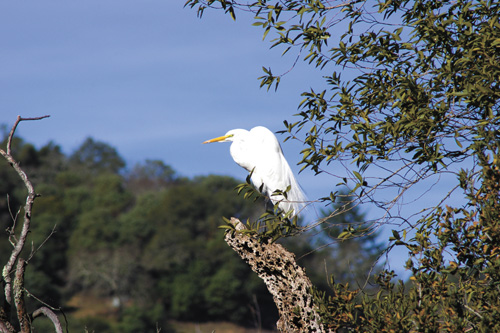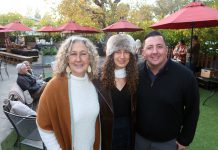Despite the near-freezing temperatures, a dozen people gathered one early Saturday morning in January at the base of Warm Springs Dam at Lake Sonoma. The group was mixed, including both young and old. Some brought walking sticks, others had binoculars hanging from their necks. These men and women all had one thing in common: birding.
There was much rubbing together of hands as the group, led by Madrone Audubon Society vice president Gordon Beebe, made its way up above a series of ponds beneath the dam. Beebe cautioned the group, all participants of a beginners bird walk, not to crowd around and stay quiet, and they peered down the slope to witness the winter months’ avian visitors — ducks. But not just any ducks, these were Goldeneyes and American Wigeons, Common Mergansers and, the day’s objective, a handful of Wood Ducks.
“Right now, this time of year, you’re seeing a lot of birds from far away coming to California, coming to spend the winter,” California Audubon’s communications director, Garrison Frost, said. “We’re seeing all the ducks, this is duck time. They typically go and breed over the summer up in the north, but right now they’re wintering in California.”
As the sun rose higher, the bird walk group began shedding layers and slowly making its way around the base of the dam. They were observing a black waterfowl called a coot when a cry went up, “It’s a dipper!”
Sure enough, on a rock in the spillway of the dam bobbed an American Dipper, periodically jumping into the water and splashing around. Between the dipper and a Rock Wren, spotted nearby, the guide Beebe was impressed by the walk’s haul of sightings.
“Keep it up, you guys,” he said, joking, “I’m not sure this qualifies as a beginners bird walk any more.”
The beginners bird walk was one of several events regularly scheduled by the Madrone Audubon Society for Sonoma County. Other outings are in a variety of destinations such as Chico, Lake County, Sebastopol and Petaluma, but chapter president Susan Kirks maintained that travel is not a requirement for birding.
“You can walk out into your own back yard, or bike to the local park with a pair of binoculars or join us on our outings,” Kirks said. “Travel as briefly or as far as you like.”
West Sonoma County Union High School District superintendent Keller McDonald first fell into birding when he was 12 years old, he said.
“I was on a camping trip with my family and there were birds everywhere. Now, I am just aware of and paying attention to birds wherever I am everyday,” McDonald said “I carry a bird book and binoculars with me most of the time.”
Though he doesn’t participate in organized bird walks, McDonald said he has traveled as far as Arizona and Scotland on birding vacations. But McDonald also agreed that travel isn’t required to enjoy birding.
“The beauty of birding is that it can be done by people of any age and of any ability,” he said. “It’s great fun to identify a new bird, tell where to expect it and understand its behaviors. As weird as it sounds, it feels like a friend.”
It’s that connection with the birds, through identification, California Audubon’s Frost said, that tends to hook new birders.
“There’s a really interesting thing that happens when you learn the name of the bird you’re looking at,” he said. “I’ve got a seven-year-old daughter, and when I told her the name of the black bird that was coming into our yard every day, instead of just being the black bird with the white chest, it became a Black Phoebe. That’s a really weird connection that you make and a lot of people, when they experience it, suddenly get really into birding and they go out and buy the binoculars, and they buy the bird book and they get sucked into it.”
For the uninitiated, introduction to birding can be as simple as showing up to one of the Madrone Audubon’s beginners bird walks, the next of which is Feb. 2 at Hudeman Slough, south of Sonoma. Alternatively, McDonald recommended recruiting a friend who is already into birding, going out to the coast and having them help distinguish the variety of shorebirds, waterfowl and raptors from one another.
Tom Reynolds, a volunteer with the Sonoma County Parks and Recreation department, also leads beginners bird walks and photography classes.
His interest in birds came about more from a desire to take their photos, he said.
“I wasn’t really a birder until about eight years ago,” Reynolds said. “Some people like to learn the Latin names and all the terminology, but I’m more interested in capturing the images.”
As an expert on the 50-odd regional parks in the county, Reynolds has his opinions on which make for the best birding.
“Shollenberger Park, which is in Petaluma, is probably the premiere birding spot in Sonoma County as far as the number birds and waterfowl, like ducks and geese,” he said.
Back at Lake Sonoma, as the beginners bird walk wound down, one of the aspiring birders heard the piercing call of a hawk from the underbrush, “What’s that?” they asked.
“That’s a mimic,” bird walk leader Gordon Beebe said. “The Steller’s Jay imitates a hawk to force other birds out of its feeding area.”
The appointed hour for the four-hour bird walk to end had come and gone, but the novice and expert birders alike still eagerly stopped and pointed out Hutton’s Vireos, Purple Finches and breathlessly watched a male Anna’s Hummingbird performing an aerobatic display dive for a female. It seemed like they all had the birding bug that day.









